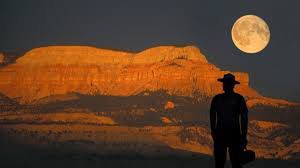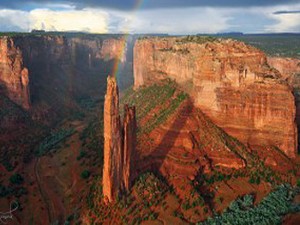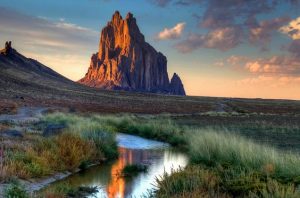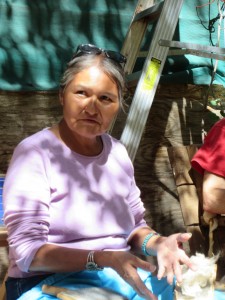(Join the Earth Walks program in a three day journey to Chaco Canyon October 6-8, 2018 camping under the stars, guided by a New Mexico Pueblo family who consider the site as their ancestral homeland. For information on cost and registration: https://earthwalks.org/ )
At an elevation of 6,200 feet, Chaco is a high desert, sun-scorched in the summer and bitterly cold in the winter. Despite these harsh conditions, evidence of human presence in the area stretches back to as early as 2900 BC. These groups were largely nomadic, until around AD 200, when the first farmers settled in the area and built small pit houses.
Then in roughly AD 850, a great change took place. The people began building in a radically different manner, constructing massive stone buildings unlike any that had been built before. These structures soared to four or five stories and contained up to seven hundred rooms and dozens of mostly circular underground ceremonial rooms.
The architecture was a feat of engineering, often built along celestial alignments, they included water-collection systems and were linked to outlying communities by an extensive network of roads. These elaborate buildings evidence a sophisticated and highly organized culture, with Chaco Canyon at its center.
The people of Chaco demonstrated extraordinary observations of astronomical phenomena which they incorporated into their buildings by designing, orienting and locating their major buildings in relationship to solar and lunar events. This required advanced architectural and design skills, scientific observation and social cohesion. Some think the civilization that flourished here parallels that of Aztec, Mayan and Inca cultures.



 Join us for this special opportunity in creative arts and service learning. We’ll be based at Bodhi Manda Zen Center in Jemez Springs, NM with opportunity for rest, relaxation and participation in meditation practice if you wish. Abbess Jiun Hosen will warmly welcome the group and explain their traditional practices at Bodhi.
Join us for this special opportunity in creative arts and service learning. We’ll be based at Bodhi Manda Zen Center in Jemez Springs, NM with opportunity for rest, relaxation and participation in meditation practice if you wish. Abbess Jiun Hosen will warmly welcome the group and explain their traditional practices at Bodhi. Healing hot springs are located at the Center, adjacent to the Jemez River.
Healing hot springs are located at the Center, adjacent to the Jemez River. Friday, March 31 we will meet with Jemez Pueblo flute maker and player Marlon Magdalena. Marlon says, “I proudly participate in all aspects of Jemez Life; for instance, I speak the Jemez Language, I plant Jemez corn, sing Jemez songs, and dance Jemez Dances. I am proud that I am from a place that still continues our ancient ways of life.”
Friday, March 31 we will meet with Jemez Pueblo flute maker and player Marlon Magdalena. Marlon says, “I proudly participate in all aspects of Jemez Life; for instance, I speak the Jemez Language, I plant Jemez corn, sing Jemez songs, and dance Jemez Dances. I am proud that I am from a place that still continues our ancient ways of life.” Marlon has been an artist for much of his life and creates paintings and traditional crafts. He also makes and performs on a wide variety of hand-carved flutes. He will lead us in the making of traditional cane flutes and explain the important meaning of flutes in the life of Pueblo people. (See:
Marlon has been an artist for much of his life and creates paintings and traditional crafts. He also makes and performs on a wide variety of hand-carved flutes. He will lead us in the making of traditional cane flutes and explain the important meaning of flutes in the life of Pueblo people. (See: 


